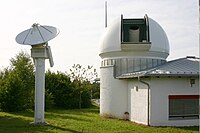
Photo from wikipedia
Galileo, BeiDou, QZSS, and NavIC are emerging global navigation satellite systems (GNSSs) and regional navigation satellite systems all of which are equipped with laser retroreflector arrays for range measurements. This… Click to show full abstract
Galileo, BeiDou, QZSS, and NavIC are emerging global navigation satellite systems (GNSSs) and regional navigation satellite systems all of which are equipped with laser retroreflector arrays for range measurements. This paper summarizes the GNSS-intensive tracking campaigns conducted by the International Laser Ranging Service and provides results from multi-GNSS orbit determination using solely SLR observations. We consider the whole constellation of GLONASS, all active Galileo, four BeiDou satellites: 1 MEO, 3 IGSO, and one QZSS. We analyze the influence of the number of SLR observations on the quality of the 3-day multi-GNSS orbit solution. About 60 SLR observations are needed for obtaining MEO orbits of sufficient quality with the root mean square (RMS) of 3 cm for the radial component when compared to microwave-based orbits. From the analysis of a minimum number of tracking stations, when considering the 3-day arcs, 5 SLR stations do not provide a sufficient geometry of observations. The solution obtained using ten stations is characterized with RMS of 4, 9, and 18 cm in the radial, along-track, and cross-track direction, respectively, for MEO satellites. We also investigate the impact of the length of orbital arc on the quality of SLR-derived orbits. Hence, 5- and 7-day arcs constitute the best solution, whereas 3-day arcs are of inferior quality due to an insufficient number of SLR observations and 9-day arcs deteriorate the along-track component. The median RMS from the comparison between 7-day orbital arcs determined using SLR data with microwave-based orbits assumes values in the range of 3–4, 11–16, and 15–27 cm in radial, along-track, and cross-track, respectively, for MEO satellites. BeiDou IGSO and QZSS are characterized by RMS values higher by a factor of 8 and 24, respectively, than MEO orbits.
Journal Title: Journal of Geodesy
Year Published: 2018
Link to full text (if available)
Share on Social Media: Sign Up to like & get
recommendations!